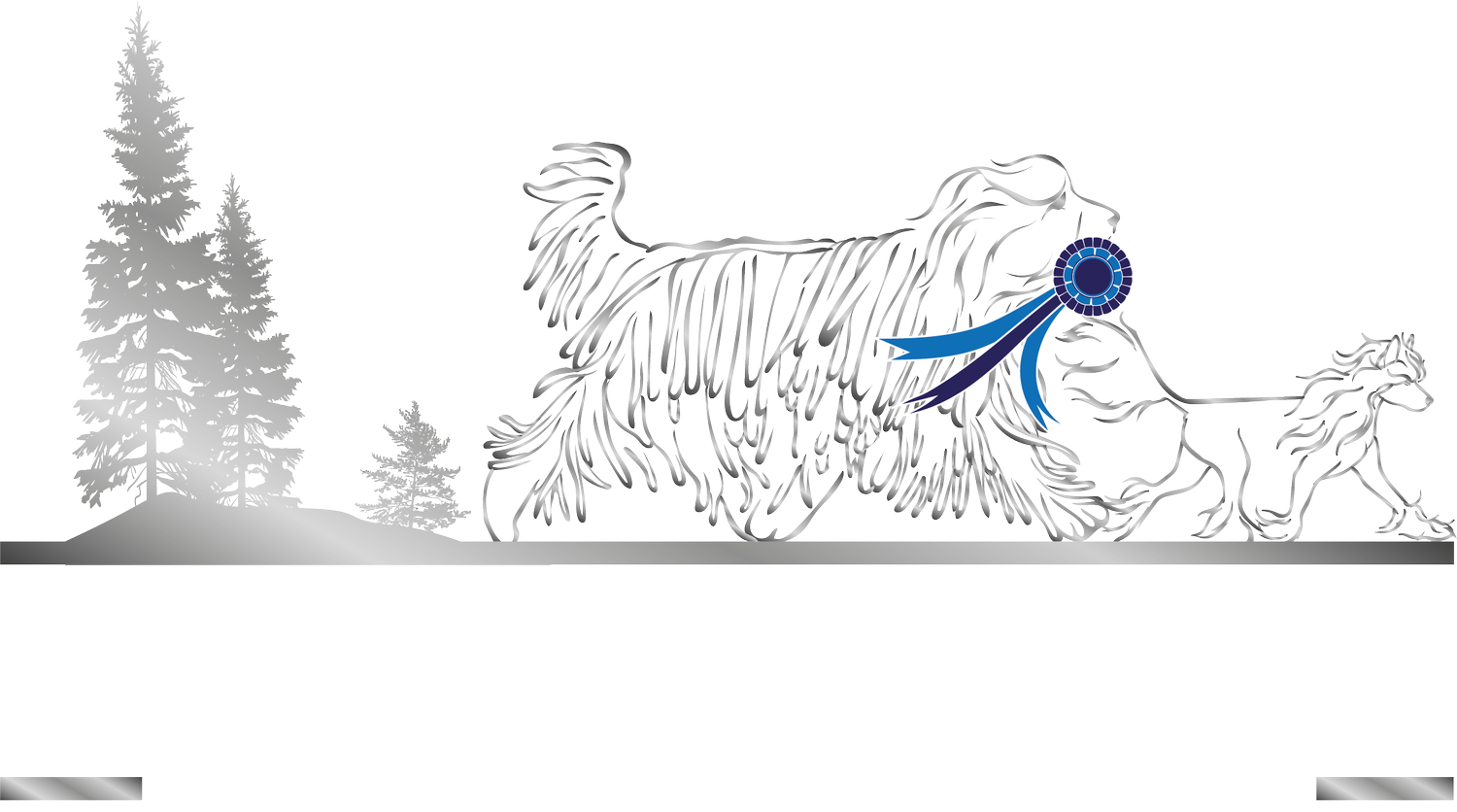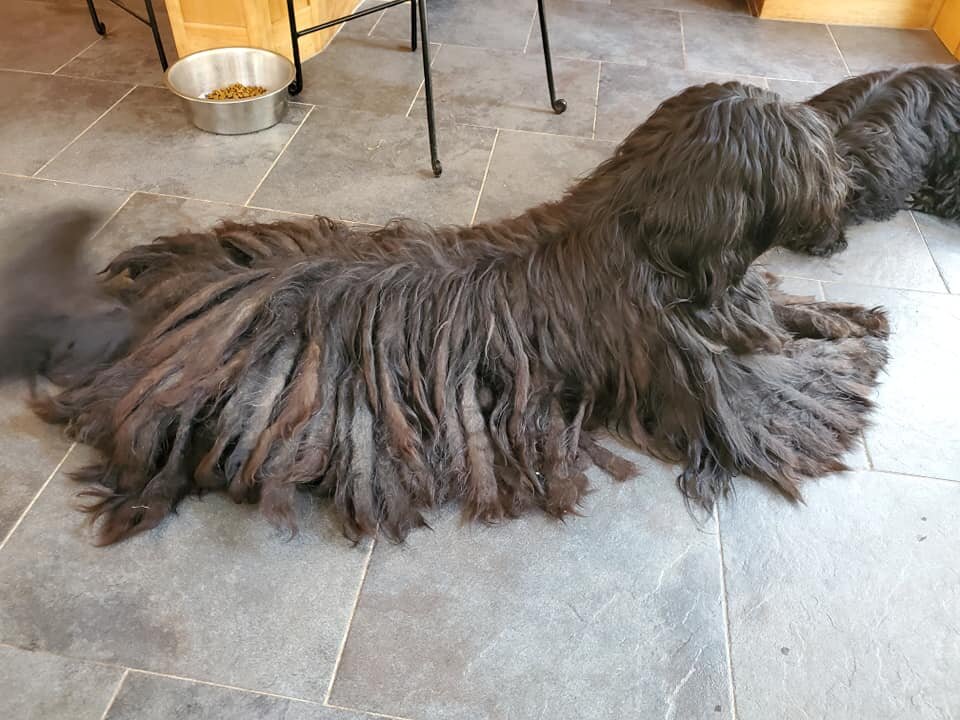The Bergamasco Coat
Bergamasco Coat Guidelines by Age
0-8 months
Keep your puppy entirely brushed with a pin brush. Brush at least weekly and preferably on a grooming table to get them used to both things. Use a comb (I recommend a rotating tooth comb) to do the face, head, chin, ears. Make sure the comb is going all the way through the hair to the skin. Do not allow matting or tangles at this age. Your puppy has a soft and easy puppy coat right now. Do pay attention to the face around the mouth for tangles and dirt. You can bathe your puppy as needed at this age without drying issues. The coat can start to change as early as 6 months in some dogs that are wooly but 8 months is average.
8 months – 1 year
REFER TO PHOTOS 1 & 2
During this time you will likely see coat changes. Some dogs will take longer. This will depend on the distribution of the three types of hair on your puppy. Every puppy varies.
The thickening of the coat you feel during this age is the beginning of the flocking in it’s infancy stage. See photo 1.
It will feel like clumping and sometimes those clumps will be near the skin and under the longer hairs so that you can feel the but not see them.
Continue to brush and follow rules for 0-8 months until this clumping begins and matting starts. Matting will happen out of nowhere so be sure to check and feel your puppies coat all over the body frequently at this age.
Do not neglect the entire head, neck and tail. Continue to keep those brushed/combed. Pay special attention to the ears, chin, cheek area. Ensure you are combing all the way through. Some dogs will require a comb some will be fine with just the pin brush.
WITH YOUR HANDS- For the areas on body that are starting to clump, ensure those clumps stay separated into segments of about 2 fingerwidths. You can make the segments on the legs and front of the body to the midline thinner. You no longer need to brush the body where mats are forming. Think of these mats as baby flocks not yet fully mature. Like cheese curds that will become more solid cheese BUT you have to open them up to make them into separate chunks.
You should see skin between each separated flock/mat.
You are opening these matted areas up like a cotton ball with your fingers, from the base near the skin and outward with your fingers pulling away from each other. Most dogs will enjoy it but some will not. Make it fun and use treats at first if you have to. I stop and give them lots of kisses and hugs every few minutes.
Check the coat daily and work it daily with your hands. The coat will go back to one big solid mat in no time if not tended to regularly at this point.
Eventually these become your “flocks”.
For the head during this time- The puppy coat is also molting at this point so you will be getting lots of soft wooly hair on your comb. You want this to all come out now. It is going to molt only at this age so this is your chance. It will not molt again during the life of the dog. Doing so will give you an easier to maintain head later. When I refer to head I mean the entire head, ears, face, cheeks, chin, muzzle, neck, area around ears.
1 year – adult
Continue as above until your cheese curd chunks become harder cheese and hold their own as separate pieces.
Go over the entire body and maintain the head and tail with your comb/pin brush and the rest of the body with your hands. Continue to check entire body weekly. Don’t forget areas like the belly, armpits, inner thighs. Ensure the dog has freedom to move all limbs without restriction from coat.
What the coat looks like once the matting becomes flocks that stay separated from each other:
REFER TO PHOTOS 3&4
Note the skin you can see around each flock and the space of hair that is not matted between skin and where the felting on the flock begins. This little space allows air circulation to the skin.
PHOTO 1 9 MONTHS OLD
PHOTO 3 TWO YEARS OLD
AVERAGE WIDTH OF AN ADULT FLOCK WITH MY HAND FOR PERSPECTIVE. 4 YEARS OLD.
IN A TRADITIONAL COAT, THIS AREA WILL HAVE MUCH LESS FLOCKING AND WILL BE MOSTLY GOAT HAIR. THIS IS THE WAY THE COAT IS SUPPOSED TO BE AS PER THE AKC AND FCI STANDARD BUT WE DO NOT SEE IT OFTEN.
PUPPY COAT 14 WEEKS
PHOTO 2 9 MONTHS OLD
PHOTO 4
ADULT FLOCK. NOTICE THE AREA BETWEEN SKIN AND WHERE THE MATTING ON THE FLOCK BEGINS. THAT AREA IS NOT MATTED AND AIR CAN CIRCULATE TO THE SKIN. THIS IS WHY IT IS NOT HARMFUL TO THE DOG. THIS WILL OCCUR NATURALLY ONCE A FLOCK IS FORMED WITH ALL 3 TYPES OF HAIR PRESENT ( THE UNDERCOAT, WOOLY COAT AND GOAT HAIR)
NOTICE THE SMOOTH SADDLE. IF YOUR DOG IS WOOLY IN THIS AREA YOU CAN STILL KEEP THE FLOCKS THINNER ON THE FRONT PART OF THE BODY.
ANOTHER EXAMPLE OF THE AREAS ON THE HEAD TO KEEP FLOCK FREE










